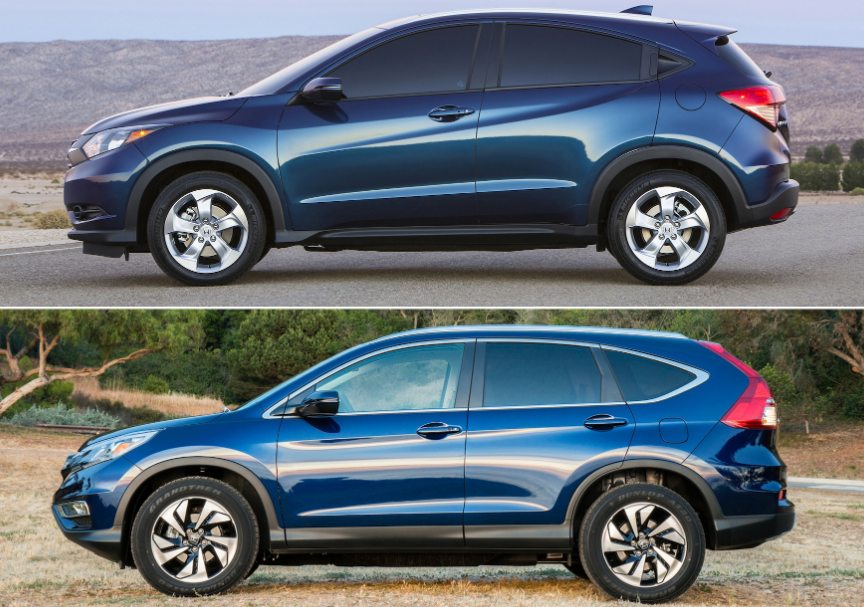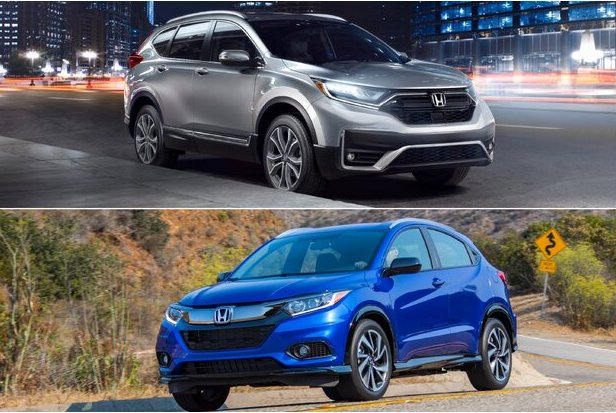In this article, we’ll outline the key distinctions between the Honda CR-V and the Honda HR-V, two of the most well-liked crossovers in North America.
Let’s see which of these crossovers is best for you. They both have a similar appearance and are reasonably priced, but they come in two very different packages and are aimed at two different types of customers.
Honda CR-V
Pros
- Excellent cabin space and comfort
- A true family-friendly model
- Still pleasant to drive
Cons
- The same lack of safety technology as competitors!
- Could be more fun
- Small media screen
With more safety features available than the model it replaces, the updated Honda CR-V range is undoubtedly an improvement over the vehicle it replaces.
However, the 2021 Honda CR-V update still falls short in terms of enhancing the midsize SUV’s safety features, and numerous rivals outperform it in a number of ways. Safety is undoubtedly a top concern if you’re a family buyer, right? If so, you might want to think about the aforementioned competitors, the Toyota RAV4, Mazda CX-5, VW Tiguan, and Subaru Forester, all of which outperform the CR-V in some way.
There is definitely something to be said for the 2021 version over the earlier models if you don’t think you need those extra safety features or if you’re just sold on the CR-V’s practical and thoughtful cabin design. The VTi 7 or the VTi, depending on how many rows you require, are the best options in this price range, in my opinion.
Honda HR-V
Pros
- Confident styling
- Ultra-frugal powertrain
- Interior fit and feel
Cons
- Pricier than rivals
- Very limited boot space
- Only a four-seater
You might conclude from looking at the 2022 HR-V that Honda has reversed course.
After all, there is less room in the trunk, there is one fewer seat, and the prices have, at first glance, increased.
In actuality, though, the HR-V presents a real challenge to the Toyotas, Mazdas, and Kias that rule the small SUV market, especially in this e:HEV L version.
The hybrid powertrain in the 2022 HR-V is fuel-efficient, the vehicle is genuinely quite excellent in terms of handling, and it is a suitably handsome vehicle.
Check More Home Services Offers Product Reviews Here!
What Are the Differences Between the Honda HR-V and the CR-V?
Honda HR-V and CR-V crossovers are well-liked on the market because of their usefulness. The HR-V costs $20,620, while the CR-V is closer to $25,050. If you wonder what the reason for the price difference between the two is, we have the answer for you. The distinctions between the Honda HR-V and CR-V are listed below.
Body Styles/Design
Honda CR-V: the current generation In spite of a recent facelift, the Honda CR-V’s youthful and sporty exterior only looks better. The redesigned bumper makes the front end, which was already busy, appear even busier. The backside maintains its relative simplicity thanks to its L-shaped taillamps.
Honda HR-V: the Due to its smaller size, the HR-V has proportions that are somewhat more upright than the CR-V. It also has Honda’s youthful front end, but the vertically mounted rear door handles make it obvious that it is the HR-V. A rear hatch spoiler and angled taillights are present in the back.
Trim Levels
There are five trim levels available for the 2019 Honda HR-V: Touring, Sport, EX, and LX. Contrarily, the 2019 Honda CR-V is available in four trim levels: LX, EX, EX-L, and Touring.

Power and Performance
The 1.8-liter four-cylinder engine in the 2019 HR-V produces 141 horsepower and 127 lb. of torque and is standard on all models.-ft. of torque. The engine has a continuously variable transmission (CVT), which contributes to the engine’s ability to get 26 MPG in the city and 31 MPG on the highway.
The Honda CR-V has an engine that is more potent. All trim levels come standard with the 190-horsepower, 1.5-liter four-cylinder engine. 28 MPG in the city and 34 MPG on the highway are achieved when the turbocharged engine is paired with a CVT.
Interior
The interior of the HR-V gives you comfort without sacrificing style. For a comfortable position while driving, the driver’s seat has a six-way power adjustment. The passengers also benefit from a number of comfort and convenience features, such as dual-zone climate control, available leather-trimmed seating surfaces, smartphone integration, and a 160-watt audio system that fills the cabin with warm, pleasant acoustics, among other things.
Inside the CR-V, there is also luxury. Dual-zone automatic climate control with air filtration, a 160-watt AM/FM audio system with four speakers and MP3/Windows Media Audio playback capability, Apple CarPlay and Android Auto compatibility, a 7-inch display, and many other comfort and convenience features are included as standard features.
Passenger and Cargo Space
The HR-V offers 100.1 cubic feet of total passenger volume, whereas the base CR-V model offers 105.9 cubic feet, which is a little more passenger volume. The headroom, shoulder room, and legroom provided by the HR-V and CR-V differ only slightly. The CR-V’s cabin space is a little bit bigger due to its slightly larger dimensions.
The HR-V offers good cargo space which stands at 24.3 cubic feet with the rear seats up and 58.8 cubic feet with rear seats down. The CR-V, on the other hand, provides a bigger cargo area. There is 75.8 cubic feet of cargo space with the rear seats down and 39.2 cubic feet with them up.
Safety
The Honda HR-V comes equipped with Honda Sensing Technologies that makes driving safer in many ways. It has a variety of advanced safety features, including a lane departure warning system and a forward collision warning system. The Honda Sensing Technologies are available as standard on all Honda HR-V models
The Honda Sensing Technologies come standard on all Honda CR-V models, with the exception of the 2WD model.
You are in a better position to choose which crossover meets your needs now that you are aware of the differences.
Three Reasons You Should Choose the HR-V
The HR-V comes equipped with a wide range of standard active safety features as well as a comprehensive package. Yes, the Honda Sensing suite of features—including automatic emergency braking, lane-departure warning, and adaptive cruise control—is available on even the base model.
The head and legroom for front and rear passengers are comparable to the CR-V thanks to a well-appointed interior. And even though the HR-V’s trunk is only one-third as large as that of its big brother, it is still among the most spacious in the subcompact segment.
Finally, the HR’V’s Magic Seats in the rear — with their seat bottoms that fold up as easily as in movie theaters — frees a practico-pratique area in the rear passenger compartment.
Three Reasons You Shouldn’t Choose the HR-V
The torsion-beam rear suspension of the Honda HR-V is its biggest weakness because it lacks the independent suspension’s comfort and compliance. For this reason alone, it may be worth investing the few extra grand for the CR-V.
Who says a smaller engine—in this case, a 1.8-litre four-cylinder with 141 horsepower and 127 lb.-ft. of torque—is better?-ft. of torque — is more frugal? In this case, despite being down some 50 horsepower compared to the CR-V’s 1.5L turbo-four, the HR-V’s “small” engine is single-overhead cam (SOHC) and lacks direct-injection, and registered fuel economy almost on par with the CR-V — 8.4 L/100 kilometres, versus 8.5 for the CR-V.
The HR-V’s infotainment system is not the most user-friendly option available right now. We continued to fiddle with the controls and get lost in a maze of menus even after spending a week behind the wheel. The Honda CR-V doesn’t necessarily make things simpler.
Which HR-V Trim Should You Choose?
the all-wheel-drive LX at the base price of $25,600. Not that this AWD system is the cream of the crop — for that, you’ll have to visit a Subaru dealership — but it gives a better resale value down the road on the used market. Even as a base LX, the HR-V is well-equipped with air conditioning, heated front seats and mirrors, and Apple CarPlay and Android Auto connectivity, in addition to Honda Sensing mentioned above.
The following two models, the $28,800 Sport and the $32,000 Touring, cost a lot (in fact, way too much in our opinion) for a subcompact crossover that doesn’t include a power liftgate, power-adjustable front seats, or even heated rear seats.
Conclusion: Why Should You Choose the CR-V Instead?
Easy — for the cargo space. The loading area even surpasses some larger, intermediate SUVs with 2,146 liters when the back seats are folded. Since the Honda CR-V’s trunk is so large, all of your outdoor toys won’t need to be mounted on the roof rack, which would compromise the vehicle’s aerodynamics and fuel efficiency. Instead, they can all fit inside without risking fuel efficiency or aerodynamics. Ou presque.
Honda CRV Vs Honda HRV FAQs
Which Car is Cheaper Between Honda CRV Vs Honda HRV?
CRV is priced at Rp 515,9 Million and HRV is priced at Rp 364,9 Million. Hence HRV is the cheapest amongst these Car.
Which Car Has More Power Between Honda CRV Vs Honda HRV?
Both the Honda CRV and HRV have engines that produce 152 horsepower and 189 Newton meters of torque, respectively. As a result, CRV is more potent than HRV.
Which Car Has More Safety Features Between Honda CRV Vs Honda HRV?
CRV safety features: Anti-Lock Braking System, Rear Seat Belts, Child Safety Locks, Vehicle Stability Control System, Height Adjustable Front Seat Belts, Passenger Airbag, Door Ajar Warning, Parking Sensors, Seat Belt Warning, Side Impact Beams, Hill-Start Assist Control, Ebd, Side Airbag-Front, Crash Sensor, Rear Camera, Driver Airbag, Brake Assist, Front Impact Beams and Engine Check Warning
HRV safety features: Driver Airbag, Rear Camera, Side Airbag-Front, Crash Sensor, EBD, Hill-Start Assist Control, Emergency Stop Signal, Anti-Lock Braking System, Rear Seat Belts, Child Safety Locks, Engine Check Warning, and Height Adjustable Front Seat Belts. Passenger Airbag, Door Ajar Warning, Downhill Assist Control, Parking Sensors, Seat Belt Warning, Side Impact Beams, Vehicle Stability Control System, ISOFIX Child Seat Mounts
Which Car Has More Comfort Features Between CRV Vs HRV?
CRV comfort features: Power Windows Front, Air Conditioner, Rear Reading Lamp, Heater, Power Windows Rear, Rear A/C Vents, Cup Holders-Front, Keyless Entry, Cruise Control, Central Console Armrest, Engine Start/Stop Button and Cup Holders-Rear
HRV comfort features: Power Windows Rear, Air Conditioner, Cup Holders-Front, Keyless Entry, Automatic Climate Control, Automatic Headlamps, Central Console Armrest, Engine Start/Stop Button, Vanity Mirror, Power Windows Front, Adaptive Cruise Control, Rear Reading Lamp and Heater
Since the Honda HRV has more comfort features than the Honda CRV, it is more comfortable than the Honda CRV.





